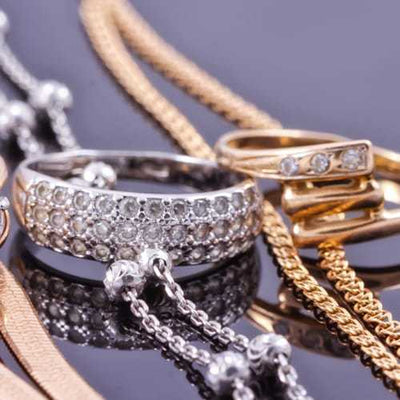When it comes to jewelry, many people just think about gold and all its various color options. However, there are a number of different metals used in jewelry making. In fact, gold barely scratches the surface of the options that buyers have when it comes to jewelry metals. Let’s take a look at the options you might encounter as you shop for your next piece.
5 Common Fine Jewelry Metals
The list of metals used in jewelry can be long, but the most popular options are gold, platinum, and sterling silver. These metals are popular for various reasons. For example, gold is a favorite because it is malleable, and adding in other metals makes it strong enough to withstand daily wear. The other metals that are added to gold can also cause a color change, which can be highly desirable depending on the wearer.
Here’s a deep dive into the most commonly used metals for fine jewelry.
1. Yellow Gold
Yellow gold is one of the most popular metals for jewelry. The classic gold look has been in style for centuries, making it a timeless choice. However, many people don’t realize that pure gold isn’t used in jewelry making because it is too soft.
Yellow gold’s purity is measured in karats. The higher the karat, the purer the gold is. However, durability is dependent on the addition of other metals, so the purer the gold, the less durable the metal is.
While gold is naturally yellow, the addition of silver or copper can enhance the warmth of the yellow tones. Out of all the colors of gold, yellow gold is the most hypoallergenic option.
2. White Gold
White gold is created by mixing gold with palladium and silver, or nickel, copper, and zinc. White gold needs to be coated with platinum or rhodium, as well. This coating helps make the metal whiter and adds durability and shine. However, this coating does eventually wear away, leaving the jewelry vulnerable; at that point, it would need to be recoated.3. Rose Gold
Pure gold is mixed with copper and silver to create the beautiful rosy hue of rose gold. The higher the concentration of copper, the more rose-colored the metal will appear.
Unlike white gold, rose gold doesn’t need to be dipped or coated because the pink tones are pure throughout the metal. However, it does need extra polishing to keep its shine compared to the other golds.
4. Platinum
An argument can be made that platinum is the best jewelry material for everyday wear due to its durability and hypoallergenic properties; it also won’t tarnish or oxidize. Even better, platinum is thirty times rarer than gold, and it will last for generations. A downside to platinum is that it is more expensive than gold due to its rarity.
Platinum used for jewelry is typically mixed with similar metals, such as palladium, iridium, rhodium, ruthenium, or osmium. However, to be sold as a platinum piece, jewelry must have a purity of at least 90% platinum. This metal is also heavier than gold.
5. Sterling Silver
Sterling silver, which is often just called silver, is the most affordable option for jewelry made from precious metals. But silver is a soft metal that must be mixed with either copper or another strong metal to be durable enough for intermittent wearing. However, standards have been set for all sterling silver jewelry to contain at least 92.5% pure silver.
This metal can range from bright to grayish white, and it can be given either a shiny or matte finish. Since silver can easily tarnish and scratch, it is important to properly store sterling silver to prevent damage.
3 Alternative Metals Options
While gold, platinum, and sterling silver are the most popular metal options for jewelry, there are a few alternative metals that have made their way into mainstream fine jewelry creation. Many of these modern options have been successful with men due to their durability.1. Cobalt
Cobalt is often used to create wedding bands for men because it is harder than stainless steel and nearly scratch-proof. In fact, cobalt is harder than titanium, platinum, gold, and silver, making it the perfect metal for more than just jewelry. Manufacturers actually use cobalt in jet aircraft engines and surgical tools, partly because it is hypoallergenic.2. Titanium
When you are looking for a metal that is just as strong as steel, but much lighter in weight, titanium is the perfect solution. Titanium has the highest strength-to-weight ratio of any metal, as it is 45% lighter than steel.
Men tend to like titanium as an option for wedding bands because of its strength, lightweight feel, and versatility of colors, which can range from white to dark depending on how it is processed. Since titanium is highly resistant to tarnishing, it is the perfect metal for daily wear pieces.
However, resizing rings made with titanium is impossible as they can’t be soldered. If your titanium ring no longer fits, it will have to be completely remade. Additionally, not all jewelers are prepared to work with this metal.
3. Tungsten
Opposite to titanium, tungsten is a heavy metal—it is actually the strongest of all metals. Because tungsten is so hard, it tends to stay shiny for long periods of time and is very difficult to scratch. The metal is known for its gray-white coloration, and rings made of tungsten are perfect for men who are rough on their hands.
If you are interested in comparing metals, especially when looking at wedding bands, come to Noe’s Jewelry in Raymore, Missouri. We offer a wide range of wedding bands in various metal types, including some of the alternative metals listed above. Call us today if you have any questions at 816-322-7227.






